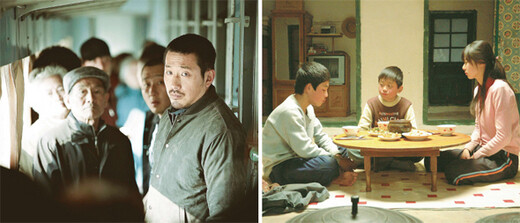hankyoreh
Links to other country sites 다른 나라 사이트 링크
‘Ethnic culture space’ developing for North Korean refugees

By Choi Won-hyung, staff writer
As of late, two ethnic groups have been appearing regularly in Korean movies: ethnic Koreans in China, the so-called Joseonjok, and Saeteomin group, meaning ‘the newly-settled people’ but practically referring to the North Korean refugees to South Korea. Such movies as Secret Reunion (2009), the Yellow Sea (2010), the Tumen River (2009), and The Journals of Musan (2010) all show that the new focus is on viewing them as ‘people on the border’ rather than as compatriots.
A new research report by Kim Seong-kyeong, a research professor at Sungkonghoe University, argues that the boundary between North Korea and China should be re-considered as more of an ‘ethnic culture space’ which has existed a long time. Kim contends that this could explain other factors beyond political and economic reasons in the North Koreans’ migration trend, according to his report from an April 20-21 symposium on “Movement of Asia” hosted by Sungkonghoe University Institute for East Asia Studies.
Professor Kim said, “Considering only the political and economic factors doesn’t allow for a complete understanding of North Korean migration. It becomes more understandable when one realizes that crossing the border for them is more of a move within the community rather than migration to another country.”
A majority of the migrants choose to move between China and North Korea over immigrating to South Korea. The total number of migrants who began fleeing famine in North Korea in the mid-1990s is thought to range from 300,000 to 1,000,000, almost 70% of which are female.
According to 2008 data on North Korean migrants from the South Korean Ministry of Unification, a surprising 68% of them were from North Hamgyeong province, near the border with China, while only 5% and 1% were from Yanggang-Do and Jagang-Do, respectively.
From the late 90s, with the border security becoming stricter there has been a change in the atmosphere in Yanbian Korean Autonomous Prefecture. Until the 1990s, North Koreans generally moved temporarily to China. Nowadays, once over the border in China, migrants must turn away from North Korea due to new restrictions on movement in the area. Kim said female migrants from the North are replacing the original role of the Joseon females who went to South Korea for jobs.
Kim argues that the particulars of each region influence migration. The mountainous topography and heavy military presence around Baekdo Mt. and in Yanggang and Jagang provinces make migration more difficult. North Koreans from North Hamgyeong province have an easier time migrating across the Chinese border because on the other side in Yanbian there is a large Korean community for them to blend into.
Professor Kim emphasized the existence of the community on the boundary. He added, “Churches of the Joseonjok or Korean fellows are playing a major role in providing space for trans-ethnic communities. In other words, they are not just physically or spatially staying together, but the entire South, North Koreans and Joseonjok are collaborating to create a trans-ethnic space for themselves”, a phenomenon Kim described as ‘expanding the boundary’.
The problem is ‘their experience on the trans-ethnic community’ is not thoroughly considered and well-accepted in South Korea. Popular explanations of their situation are ‘they are from the North, the country of the hostility’, or ‘they had no choice but to make such extreme decision’. The Cold War legacy still seems to be embedded in South Koreans’ thinking, which can prevent migrants from settling. Professor Kim argued it is critical to understand the cultural-geographical background to migration.
Translated by Lee Dong-ju, Hankyoreh English intern
Please direct questions or comments to [english@hani.co.kr]
Editorial・opinion
![[Column] Has Korea, too, crossed the Rubicon on China? [Column] Has Korea, too, crossed the Rubicon on China?](https://flexible.img.hani.co.kr/flexible/normal/500/300/imgdb/original/2024/0419/9317135153409185.jpg) [Column] Has Korea, too, crossed the Rubicon on China?
[Column] Has Korea, too, crossed the Rubicon on China?![[Correspondent’s column] In Japan’s alliance with US, echoes of its past alliances with UK [Correspondent’s column] In Japan’s alliance with US, echoes of its past alliances with UK](https://flexible.img.hani.co.kr/flexible/normal/500/300/imgdb/original/2024/0419/2317135166563519.jpg) [Correspondent’s column] In Japan’s alliance with US, echoes of its past alliances with UK
[Correspondent’s column] In Japan’s alliance with US, echoes of its past alliances with UK- [Editorial] Does Yoon think the Korean public is wrong?
- [Editorial] As it bolsters its alliance with US, Japan must be accountable for past
- [Guest essay] Amending the Constitution is Yoon’s key to leaving office in public’s good graces
- [Editorial] 10 years on, lessons of Sewol tragedy must never be forgotten
- [Column] A death blow to Korea’s prosecutor politics
- [Correspondent’s column] The US and the end of Japanese pacifism
- [Guest essay] How Korea turned its trainee doctors into monsters
- [Guest essay] As someone who helped forge Seoul-Moscow ties, their status today troubles me
Most viewed articles
- 1[Column] The clock is ticking for Korea’s first lady
- 2After 2 months of delayed, denied medical care, Koreans worry worst may be yet to come
- 3Hong Se-hwa, voice for tolerance whose memoir of exile touched a chord, dies at 76
- 4[Column] Has Korea, too, crossed the Rubicon on China?
- 5US overtakes China as Korea’s top export market, prompting trade sanction jitters
- 6Samsung barricades office as unionized workers strike for better conditions
- 7[Editorial] As it bolsters its alliance with US, Japan must be accountable for past
- 8[Correspondent’s column] In Japan’s alliance with US, echoes of its past alliances with UK
- 9All eyes on Xiaomi after it pulls off EV that Apple couldn’t
- 10[Correspondent’s column] The US and the end of Japanese pacifism